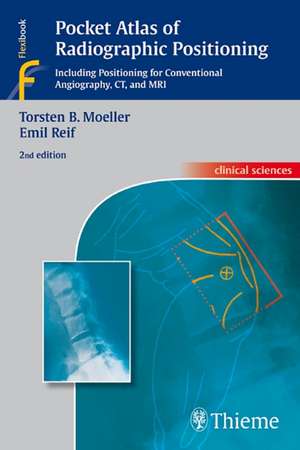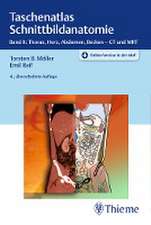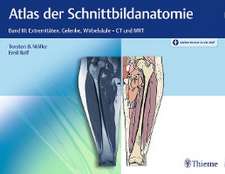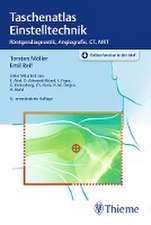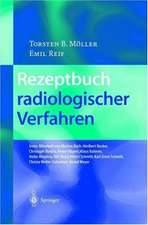Pocket Atlas of Radiographic Positioning
Autor Torsten Bert Moeller, Emil Reif, Dyan Attwood–wood, Monika Braunen Limba Engleză Paperback – 18 noi 2008
Praise for this book:Remarkable...a valuable, easy-to-use desk or pocket reference for medical imaging professionals at every level. - ADVANCE for Imaging & Radiation Oncology
Now in its second edition, Pocket Atlas of Radiographic Positioning is a practical how-to guide that provides the detailed information you need to reproducibly obtain high-quality radiographic images for optimal evaluation and interpretation of normal, abnormal, and pathological anatomic findings. It shows positioning techniques for all standard examinations in conventional radiology, with and without contrast, as well as basic positioning for CT and MRI. For each type of study a double-page spread features an exemplary radiograph, positioning sketches, and helpful information on imaging technique and parameters, criteria for the best radiographic view, and patient preparation. Clearly organized to be used in day-to-day practice, the atlas serves as an ideal companion to Moeller and Reif's Pocket Atlas of Radiographic Anatomy and their three-volume Pocket Atlas of Cross-Sectional Anatomy.
Highlights of the second edition:
Now in its second edition, Pocket Atlas of Radiographic Positioning is a practical how-to guide that provides the detailed information you need to reproducibly obtain high-quality radiographic images for optimal evaluation and interpretation of normal, abnormal, and pathological anatomic findings. It shows positioning techniques for all standard examinations in conventional radiology, with and without contrast, as well as basic positioning for CT and MRI. For each type of study a double-page spread features an exemplary radiograph, positioning sketches, and helpful information on imaging technique and parameters, criteria for the best radiographic view, and patient preparation. Clearly organized to be used in day-to-day practice, the atlas serves as an ideal companion to Moeller and Reif's Pocket Atlas of Radiographic Anatomy and their three-volume Pocket Atlas of Cross-Sectional Anatomy.
Highlights of the second edition:
- New chapters on positioning in MRI and CT, including multislice CT
- A greatly expanded section on mammography
- Special features, including information on the advantages of a specific view, variations of positions, and practical tips and tricks
- Nearly 500 excellent radiographs and drawings demonstrating the relationship between correct patient positioning and effective diagnostic images
Preț: 344.35 lei
Nou
Puncte Express: 517
Preț estimativ în valută:
65.89€ • 68.98$ • 54.52£
65.89€ • 68.98$ • 54.52£
Carte disponibilă
Livrare economică 15-29 martie
Livrare express 01-07 martie pentru 39.14 lei
Preluare comenzi: 021 569.72.76
Specificații
ISBN-13: 9783131074423
ISBN-10: 3131074426
Pagini: 358
Ilustrații: 491
Dimensiuni: 126 x 188 x 23 mm
Greutate: 0.54 kg
Ediția:2nd edition
Editura: MM – Thieme
Locul publicării:Germany
ISBN-10: 3131074426
Pagini: 358
Ilustrații: 491
Dimensiuni: 126 x 188 x 23 mm
Greutate: 0.54 kg
Ediția:2nd edition
Editura: MM – Thieme
Locul publicării:Germany
Recenzii
Any pocket-sized handbook that provides in-depth coverage of multiple medical imaging modalities is a rare and remarkable thing. The second edition of Pocket Atlas of Radiographic Positioning is just such a book, containing nearly every modality, including conventional radiography, CT, MRI, angiography, and mammography...a valuable, easy-to-use desk or pocket reference for medical imaging professionals at every level.--ADVANCE for Imaging & Radiation OncologyWe suggest this publication not only to radiologists, radiology residents, radiologic technologists and technicians, but also to professionals and students working in nuclear medicine to acquire autonomous knowledge of instruments and information. European Journal of Nuclear Medicine and Molekular Imaging March 2010This pocket book presents in a condensed but comprehensive manner the proper positioning for all radiographic procedures...This second edition has been enriched by new chapters on positioning in MRI and CT, including multislice CT, and by an expanded section on mammography...Each positioning is documented by clear drawings and by the related radiological image, except for the positions in CT and MR studies, which are presented by drawings, albeit very demonstrative...a solid companion to the three volumes Pocket Atlas of Sectional Anatomy, in which the same authors present, in a comprehensive and clear manner, the basic positioning and related radiographic images for CT and MR...will be of great value in the day-to-day practice of the radiologic technologists, but in particular it will be very useful to the Residents in Radiology.--Clinical ImagingA comprehensive pocket-sized guide of general radiography techniques, with lots of suggestions for different adaptations if the standard positions are not possible. With each technique there is a particularly good section Criteria for a Good Radiographic View which gives guidance on the optimum image, including the area or joint space that should be visuali[z]ed and its alignment. A radiograph of each position is included.--RAD Magazine
Notă biografică
Emil Reif, MDDepartment of RadiologyMarienhaus Klinikum Saarlouis - DillingenDillingen/Saarlouis, Germany
Textul de pe ultima copertă
Praise for this book:Remarkable...a valuable, easy-to-use desk or pocket reference for medical imaging professionals at every level. - ADVANCE for Imaging & Radiation Oncology
Now in its second edition, Pocket Atlas of Radiographic Positioning is a practical how-to guide that provides the detailed information you need to reproducibly obtain high-quality radiographic images for optimal evaluation and interpretation of normal, abnormal, and pathological anatomic findings. It shows positioning techniques for all standard examinations in conventional radiology, with and without contrast, as well as basic positioning for CT and MRI. For each type of study a double-page spread features an exemplary radiograph, positioning sketches, and helpful information on imaging technique and parameters, criteria for the best radiographic view, and patient preparation. Clearly organized to be used in day-to-day practice, the atlas serves as an ideal companion to Moeller and Reif's Pocket Atlas of Radiographic Anatomy and their three-volume Pocket Atlas of Cross-Sectional Anatomy.
Highlights of the second edition:
Now in its second edition, Pocket Atlas of Radiographic Positioning is a practical how-to guide that provides the detailed information you need to reproducibly obtain high-quality radiographic images for optimal evaluation and interpretation of normal, abnormal, and pathological anatomic findings. It shows positioning techniques for all standard examinations in conventional radiology, with and without contrast, as well as basic positioning for CT and MRI. For each type of study a double-page spread features an exemplary radiograph, positioning sketches, and helpful information on imaging technique and parameters, criteria for the best radiographic view, and patient preparation. Clearly organized to be used in day-to-day practice, the atlas serves as an ideal companion to Moeller and Reif's Pocket Atlas of Radiographic Anatomy and their three-volume Pocket Atlas of Cross-Sectional Anatomy.
Highlights of the second edition:
- New chapters on positioning in MRI and CT, including multislice CT
- A greatly expanded section on mammography
- Special features, including information on the advantages of a specific view, variations of positions, and practical tips and tricks
- Nearly 500 excellent radiographs and drawings demonstrating the relationship between correct patient positioning and effective diagnostic images
Descriere
Praise for this book:Remarkable...a valuable, easy-to-use desk or pocket reference for medical imaging professionals at every level. - ADVANCE for Imaging & Radiation Oncology
Now in its second edition, Pocket Atlas of Radiographic Positioning is a practical how-to guide that provides the detailed information you need to reproducibly obtain high-quality radiographic images for optimal evaluation and interpretation of normal, abnormal, and pathological anatomic findings. It shows positioning techniques for all standard examinations in conventional radiology, with and without contrast, as well as basic positioning for CT and MRI. For each type of study a double-page spread features an exemplary radiograph, positioning sketches, and helpful information on imaging technique and parameters, criteria for the best radiographic view, and patient preparation. Clearly organized to be used in day-to-day practice, the atlas serves as an ideal companion to Moeller and Reif's Pocket Atlas of Radiographic Anatomy and their three-volume Pocket Atlas of Cross-Sectional Anatomy.
Highlights of the second edition:
Now in its second edition, Pocket Atlas of Radiographic Positioning is a practical how-to guide that provides the detailed information you need to reproducibly obtain high-quality radiographic images for optimal evaluation and interpretation of normal, abnormal, and pathological anatomic findings. It shows positioning techniques for all standard examinations in conventional radiology, with and without contrast, as well as basic positioning for CT and MRI. For each type of study a double-page spread features an exemplary radiograph, positioning sketches, and helpful information on imaging technique and parameters, criteria for the best radiographic view, and patient preparation. Clearly organized to be used in day-to-day practice, the atlas serves as an ideal companion to Moeller and Reif's Pocket Atlas of Radiographic Anatomy and their three-volume Pocket Atlas of Cross-Sectional Anatomy.
Highlights of the second edition:
- New chapters on positioning in MRI and CT, including multislice CT
- A greatly expanded section on mammography
- Special features, including information on the advantages of a specific view, variations of positions, and practical tips and tricks
- Nearly 500 excellent radiographs and drawings demonstrating the relationship between correct patient positioning and effective diagnostic images
